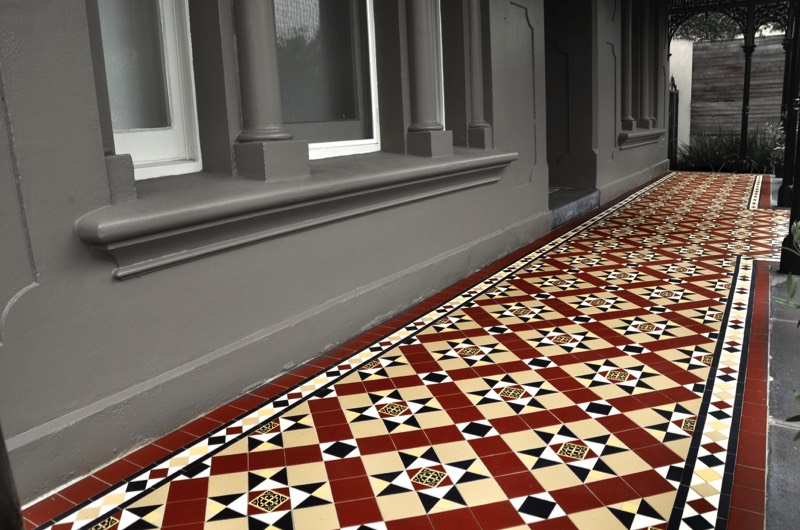How Much Does It Cost To Tile with Victorian/Tesselated Tiles?

Cost to Tile with Victorian/Tesselated Tiles
| job | Description | labour |
| 1 | Replacing a tiled front path. Let’s assume it’s 1 metre wide and 5metres long. You want new black and white 100mm tiles, laid in a diamond pattern, with a single tile border. The concrete base is fine. That’s 1 man 2.5 days including adhesive & grout | £475 |
| Plus the tiles for the above | £200 | |
| 2 | To dig up the existing and lay a new screed for the above. That’s 1 man 2 days | £375 |
| Plus materials, skip etc. for the above | £250 | |
| 3 | Replace a tiled hallway. Let’s assume its 1.5m wide by 4m long (6m²) on an existing OK screed. The tiles will be 150mm² in cream and red commonly known as “Ennerdale”. There will be a border, a central pattern and a little extension into an adjacent doorway. This will take 1 man 5 days with sealing, tipping etc. | £975 |
| Plus materials etc. for the above | £500 | |
| 4 | To remove the existing cracked one and lay a new waterproof screed for the above. 1 man 2 days | £375 |
| Plus materials, skip etc. for the above | £250 | |
| 5 | To replace the boards with marine ply, 1 man 1 day plus £130 for the plywood etc. | £300 |
“Labour” at £175 a day (tradesman) £100 (labourer), includes incidental fixings etc. and tipping charges. “Materials” if mentioned, are larger things (a boiler) and stuff only you can choose (tiles etc). Also VAT must be added all round.
Information Sheet on Fixing Victorian Tessellated Tiles
Cost?……….About 50% more than normal tiling is the immediate answer…. and then some!
Why? because Victorian tiles can be quite small and they are almost always laid in “interesting” designs and “interesting” costs much more than “bog standard”.
Unless you are replacing like for like, YOU need to know two things before you speak to tilers. Which colours and which design do you want? For this you need inspiration, so you must trawl the internet and/or stroll around the neighbourhood.
Don’t try to have a damaged area repaired, the new tiles won’t match and will stick out like a chav at a polo match. If you want to replace like for like though, you should take a few photos for reference.
(I’ve nothing against the working classes by the way, I often used to sport a tracksuit whilst crossing the quad when captaining the house at rugger).
When the old tiles are removed, inspect the base. If it’s concrete it will be 100 years old. If it’s cracked, lay a new one and make sure it’s dry and “gone off”, before new tiles are laid. It must also be flat and smooth – so concrete is out – he needs to lay a sharp sand screed and this requires experience.
Planning is everything, this is why you need an experienced bloke. You need to outline precisely what you want and where you want it. Don’t leave decisions for him to make on his own, when you’re both out at work.
If you are considering fitting tiles in a previously untiled hallway, the existing floor may be boarded. No one will tile on floor boards. They must all come up and 18mm thick plywood sheets screwed down instead (preferably marine ply). Some guys won’t even allow this but insist on laying a screed on concrete.
That leaves 2 more areas to cover. Firstly, different adhesives must be used for concrete and wood (he will know what to use). Now what about sealing? This can get quite complicated so do a bit of research before you ask the tiler’s opinion. There’s initial grout removal, penetrating protection, surface cleaning and even annual cleaning to consider.
FAQs 'traffic light' guide
-
What's easy about this job…
Open or CloseIt's only something a real specialist should attempt.
-
What's tricky about this job…
Open or CloseEverything. It's fiddly, precise work that will look RUBBISH if you don't get a dedicated pro in.
-
Potential problems with regards to this job…
Open or CloseUnless you get a reputable specialist (you will want to see their previous work) you may as well flush your money down the WC. These tiles need to be fitted perfectly in order to look stunning!
www.buildingsheriff.com
Copyright The Building Sheriff Ltd 2017